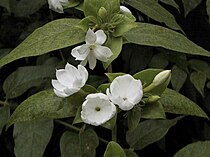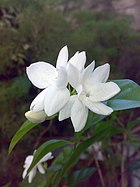

Jasminum sambac (Arabian jasmine or Sambac jasmine)[1][2] is a species of jasmine native to tropical Asia, from the Indian subcontinent to Southeast Asia.[3][4] It is cultivated in many places, especially West Asia, South Asia and Southeast Asia. It is naturalised in many scattered locales: Mauritius, Madagascar, the Maldives, Christmas Island, Chiapas, Central America, southern Florida, the Bahamas, Cuba, Hispaniola, Jamaica, Puerto Rico, and the Lesser Antilles.[5][6][7]
Jasminum sambac is a small shrub or vine growing up to 0.5 to 3 m (1.6 to 9.8 ft) in height. It is widely cultivated for its attractive and sweetly fragrant flowers. The flowers may be used as a fragrant ingredient in perfumes and jasmine tea. It is the Floral emblem of the Philippines, where it is known as Sampaguita,[8] is a small, white, fragrant flower that is commonly used in religious ceremonies, garlands, and floral offerings. It symbolizes purity, simplicity, and humility, and it holds a special place in Filipino culture and traditions [n 1] as well as being one of the three national flowers of Indonesia, where it is known as Melati putih.
Origins[edit]

The English common name of "Arabian jasmine", Jasminum sambac is due to it being widely cultivated in Southwest of Saudi Arabia, Yemen and Oman. Early Chinese records of the plant points to the origin of Jasminum sambac as eastern South Asia and Southeast Asia. Jasminum sambac (and nine other species of the genus) were spread into Arabia and Persia by man, where they were cultivated in gardens. From there, they were introduced to Europe where they were grown as ornamentals and were known under the common name "sambac" in the 18th century.[9][10]
The Medieval Arabic term "Zanbaq" denoted jasmine flower-oil from the flowers of any species of jasmine. This word entered late medieval Latin as "Sambacus" and "Zambacca" with the same meaning as the Arabic, and then in post-medieval Latin plant taxonomy the word was adopted as a label for the J. sambac species.[11] The J. sambac species is a good source for jasmine flower-oil in terms of the quality of the fragrance and it continues to be cultivated for this purpose for the perfume industry today. The Jasminum officinale species is also cultivated for the same purpose, and probably to a greater extent.
Cultivation[edit]
The sweet, heady fragrance of Jasminum sambac is its distinct feature. It is widely grown throughout the tropics from the Arabian peninsula to Southeast Asia and the Pacific Islands as an ornamental plant and for its strongly scented flowers.[12] Numerous cultivars currently exist.[13]
Cultivars
There are numerous cultivars of Jasminum sambac which differ from each other by the shape of leaves and the structure of the corolla. The cultivars recognized include:
- 'Maid of Orleans' – possesses flowers with a single layer of five or more oval shaped petals. It is the variety most commonly referred to as sampaguita and pikake.[5][14] It is also known as 'Mograw', 'Motiya', or 'Bela'.[15]
- 'Belle of India' – possesses flowers with a single or double layer of elongated petals.[15]
- 'Grand Duke of Tuscany' – possesses flowers with a doubled petal count. They resemble small white roses and are less fragrant than the other varieties. It is also known as 'Rose jasmine' and 'Butt Mograw'.[15] In the Philippines, it is known as kampupot.[5]
- 'Mysore Mallige' – resembles the 'Belle of India' cultivar but has slightly shorter petals with distinct and immense fragrance.[15]
- 'Arabian Nights' – possesses a double layer of petals but is smaller in size than the 'Grand Duke of Tuscany' cultivar.[15]
Importance[edit]
Philippines[edit]

Jasminum sambac (Filipino and Philippine Spanish: sampaguita) was adopted by the Philippines as the National flower on 1 February 1934 via Proclamation No. 652 issued by American Governor-General Frank Murphy.[16][17][18]
Indonesia[edit]

Jasminum sambac (Indonesian: melati putih) is one of the three national flowers in Indonesia, the other two being the moon orchid and the giant padma.[17] Although the official adoption were announced only as recent as 1990 during World Environment Day and enforced by law through Presidential Decree No. 4 in 1993,[19] the importance of Jasminum sambac in Indonesian culture long predates its official adoption. Since the formation of Indonesian republic during the reign of Sukarno, melati putih is always unofficially recognized as the national flower of Indonesia. The reverence and its elevated status mostly due to the importance of this flower in Indonesian tradition since ancient times.
Southern Asia[edit]
Jasmine is considered to be a sacred flower in Hinduism. It is one of the most commonly grown ornamentals in Republic of India, Bangladesh and Pakistan, where it is native.[20][18] At Indian weddings, the bride often adorns her hair with garlands made of Mogra, either around a bun or wrapped across a braid.
Sri Lanka[edit]
In Sri Lanka it is widely known as pichcha or gaeta pichcha. The name sithapushpa and katarolu are also used in older texts. The flowers are used in Buddhist temples and in ceremonial garlands.
See also[edit]
- List of Jasminum species
- Jasmine
- Jasminum multiflorum – the Indian Jasmine
- Jasminum officinale – the Common Jasmine
- Cananga odorata, the ylang-ylang, another plant widely used in perfumes
References[edit]
- ↑ Cite error: Invalid
<ref>tag; no text was provided for refs namedGRIN - ↑ "Jasminum sambac (L.) Aiton, Oleaceae". Pacific Island Ecosystems at Risk (PIER). 18 October 2006. Retrieved 8 May 2011.
- ↑ "Jasminum sambac". Missouri Botanical Garden. Retrieved 25 November 2019.
- ↑ Olveros-Belardo, Luz; Smith, Roger M.; Ocampo, Milagros P. (990). "Some Components of the Absolute of the Rowers of Jasminum sambac (l.) Ait" (PDF). Transactions of the National Academy of Science and Technology. 12 (6): 129–140.
- ↑ 5.0 5.1 5.2 Fernando C. Sanchez Jr.; Dante Santiago; Caroline P. Khe (2010). "Production Management Practices of Jasmine (Jasminum sambac (L.) Aiton) in the Philippines" (PDF). Journal of the International Society for Southeast Asian Agricultural Sciences. 16 (2): 126–136. Archived from the original (PDF) on 28 June 2011. Retrieved 8 May 2011. Unknown parameter
|url-status=ignored (help) - ↑ "Plants of the World Online | Kew Science". Plants of the World Online.
- ↑ "Biota of North America Program".
- ↑ Pangilinan Jr., Leon (3 October 2014). "In Focus: 9 Facts You May Not Know About Philippine National Symbols". National Commission for Culture and the Arts. Archived from the original on 26 November 2016. Retrieved 8 January 2019. Unknown parameter
|url-status=ignored (help) - ↑ 胡秀英 (Hu Shiu-Ying) (2003). 秀苑擷英 秀苑擷英: 胡秀英敎授論文集 (in 中文 and English). 商務印書館(香港). pp. 263–265. ISBN 978-962-07-3152-5. Search this book on

- ↑ A.K. Singh (2006). Flower Crops: Cultivation and Management. New India Publishing. pp. 193–205. ISBN 978-81-89422-35-6. Search this book on

- ↑ Dictionnaire étymologique des mots français d'origine orientale, by L. Marcel Devic, year 1876, page 201; downloadable. Additional details at zambacca (Alphita, mid 15th century); sambacus(Simon of Genoa, late 13th century); زنبق = دهن الياسمين Archived 29 October 2013 at the Wayback Machine(Zanbaq = "jasmine oil" in Lisan al-Arab, late 13th century).
- ↑ Cite error: Invalid
<ref>tag; no text was provided for refs namedarabnews - ↑ Cite error: Invalid
<ref>tag; no text was provided for refs namedbanerji - ↑ Cite error: Invalid
<ref>tag; no text was provided for refs namedleonhardt - ↑ 15.0 15.1 15.2 15.3 15.4 "Jasmine". House Plants, HCC Southwest College. Archived from the original on 8 May 2011. Retrieved 8 May 2011. Unknown parameter
|url-status=ignored (help) - ↑ "Philippine Fast Facts: National Flower: Sampaguita". National Commission for Culture and the Arts, Republic of the Philippines. Archived from the original on 15 September 2008. Retrieved 8 May 2011. Unknown parameter
|url-status=ignored (help) - ↑ 17.0 17.1 "ASEAN National Flowers". ASEAN secretariat. Archived from the original on 9 January 2011. Retrieved 8 May 2011.
- ↑ 18.0 18.1 Cite error: Invalid
<ref>tag; no text was provided for refs namedwhistler - ↑ "Keputusan Presiden No. 4 Tahun 1993" (PDF). Archived from the original (PDF) on 2 April 2012. Unknown parameter
|url-status=ignored (help) - ↑ Cite error: Invalid
<ref>tag; no text was provided for refs namedskaria
External links[edit]
 Media related to Jasminum sambac at Wikimedia Commons
Media related to Jasminum sambac at Wikimedia Commons Data related to Jasminum sambac at Wikispecies
Data related to Jasminum sambac at Wikispecies
Lua error in Module:Taxonbar at line 146: attempt to index field 'wikibase' (a nil value).
Notes[edit]
- ↑ “The Official Floral Emblem of the Philippines” respectively
- CS1 uses 中文-language script (zh)
- CS1 中文-language sources (zh)
- Jasminum
- Flora of tropical Asia
- State symbols of Hyderabad (Osmanistan)
- State symbols of Andhra Pradesh
- National symbols of the Unitary State of Indonesia
- National symbols of the Philippines
- Plants described in 1753
- Taxa named by Carl Linnaeus
- Garden plants of Asia




